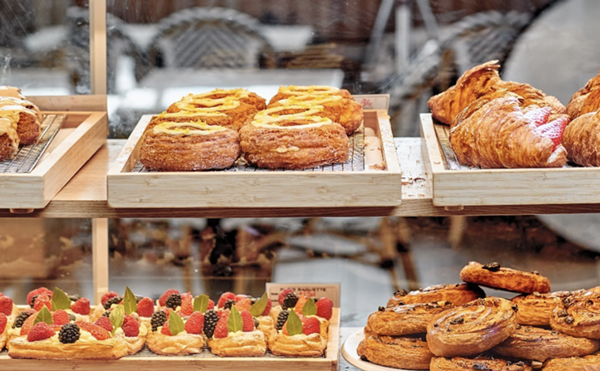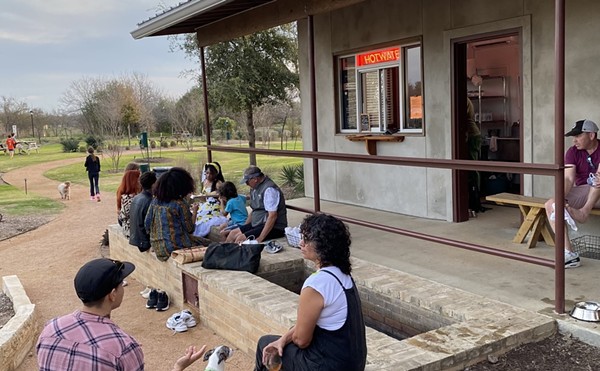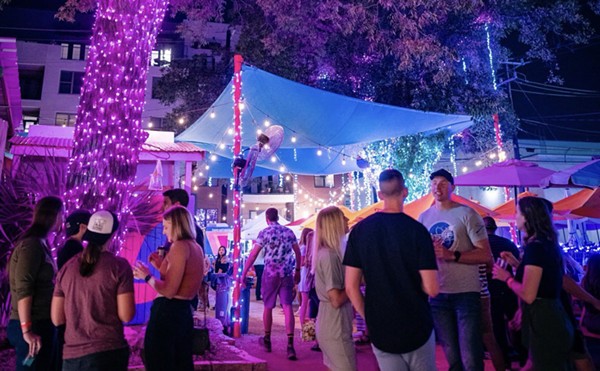Omniboire accordingly decided to explore naked chardonnay, partly to see if Robinson was right: Chardonnay, “in a high proportion of cases … is merely a very sound raw material ready to receive the stamp of soil, climate or winemaker.” We enlisted Olivier Bourgoine of Serendipity Wines to put together a selection of unoaked chardonnays from around the world. You might know that a Frenchman would sidestep California, but he did see fit to include Australia, along with France and Italy. Here are the results, as judged by panelists Janet Easterling (a former Ruth’s Chris sommelier, now with Beeman’s on I-10), Brian West (chef-owner of Café Paladar), and Jeff Bridges, owner of Copa Wine bar and our host for the event.
The 2006 Casot dan Vian Cagiola, from Scagliola in the Asti area of Italy’s Piemonte, was “definitely the standout,” according to Bridges, who thought it “hit all the nerve receptors.” Easterling found it “pure — no malolactic, no sur lies,” though as first served, a little too cold, she thought it “green … almost like a sauvignon blanc.”
Underlining chardonnay’s adaptability to different conditions, our number-two wine, the 2003 Cinquante-Cinq Chardonnay, Vin de Pays d’Oc came from France’s warm and low-lying Languedoc. 2003 was also a very warm year, and the wine did, in Bridge’s opinion, have a slight “cooked quality.” (Newer vintages are fresher, in fact.) But one man’s “cooked” is another woman’s complexity. It was Easterling’s favorite wine, and she detected a “nutty/lees-y” quality along with honeysuckle aromas. My second-favorite wine, I gave it added points for its whiffs of minerality.
Continuing to circle the globe, the wine behind door number three (we taste all of these blind, remember) turned out to be an Aussie product, the 2005 Red Mud South Australia Unoaked Chardonnay. After an initial funk blew off in the nose, it proved to be “a nice unoaked chardonnay” in Easterling’s opinion. Bridges detected a mustiness to start with, but a “180-degree turnaround” between nose and palate. West found “bigger flavors,” and we all thought it improved with time in the glass. (Moral: Don’t serve chardonnay too cold; an ice bucket is rarely required.)
We’re back to France for wine number four, the 2006 Jaboulet — Vercherre Chablis — the real stuff, not the fake juice in a jug. “There’s a watermelon thing going on there,” offered West, while Easterling found citrus at first, then “lemon custard” on retasting. “Tangerine first, now papaya,” claimed Bridges, again emphasizing the grape’s chameleon character.
Of the wines that didn’t make the 13/20 scoring cutoff, another Jaboulet-Vercherre product, the 2005 Macon-Village, came the closest and was a personal favorite. Bridges thought it had a toastiness and vanilla quality that suggested oak and called it “cool for porch or pool,” while Easterling noted that it started well but dropped off quickly — a characteristic shared by almost all of the wines tasted.
Drink young and drink quickly thus emerges as a motto. Another might be, don’t be afraid of a little well-integrated oak; it contributes to ageability and complexity, and simply produces a different product. All hail the emperor — with or without clothes. l
The wines for this tasting were all purchased at Bootlegger’s Fine Wines, Spirits & Chocolates at West Avenue and Lockhill-Selma. Some are also available at Central Market and Saglimbeni Fine Wine, and on restaurant wine lists such as Eclipse Café’s.


Scagliola 2006 Casot dan Vian Cagiola,
Piemonte, $20-$22
Apple and white flowers with layers of spice


Cinquante-Cinq 2003 Chardonnay,
Vin de Pays d’Oc, $10-$12
Floral/tropical, long finish


Red Mud 2005 Chardonnay Unoaked,
South Australia, $15
Bright, clean citrus notes, with pineapple backbeat

Jaboulet-Vercherre 2006 Chablis,
Appellation Chablis Controlée, $20
Tart apple and citrus, shading to tropical with time


















